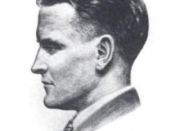Following a tough and turbulent beginning, a young country discovered industry, and in doing so, found reform and revolution. These elements saw the country down an unexplored road of technological and political evolution. This was America, a nation that had fought for its freedom, and a nation that had achieved it. The concept of freedom, however, was quite new to the peoples of the new world, and became a dangerous thing to possess. Swiftly, America adapted governments and amendments to sustain its rapidly growing world. What this world would do with its freedoms was clearly left up to the people.
In the 1920s, these very freedoms were tested to the very limit. The changes wrought in this period were far-reaching and quite enduring. By the time it had elapsed, the work week had dropped from sixty to forty-eight hours. For the first time in what seemed more than a century, the populous considered play as important as work, and the weekend family outing and vacation had become a demanded right by the workers of unions and salary paying jobs.
In this period, dress hemlines became lenient, dashing from the ankles to the knees, a height that, only a decade before, had been observed in a house of ill repute. Makeup became popular. Dresses became looser and swimsuits became tighter"ÃÂboth became quickly skimpy in nature. This was one of the most notable changes of the decade; the dissolving of rigid morality and an explosion in new industrially fabricated synthetic materials such as rayon.
That was not all. Social barriers were felled"ÃÂthanks partially to Prohibition"ÃÂwhere the rich and the commoner rubbed elbows in the common pursuit of a drink. Gangsters and captains of industry consorted freely. These times and circumstances gave birth to the popular boxing matches and sports common of the 20s. Business boomed, paper wealth rocketed much like the sciences that became prominent and a new and improved field. Cars became a symbol of the American person. Gizmos were invented to make life easier. The media bloomed and marketed to the public the propaganda that would consume the ideal American standard. It was a fast paced modern life that lead to excessive, irrational pursuits, and short lived fads.
The fun and wild reckless exploration of the twenties came to an invariable close in the 30s as the great Crash decimated the economy. Times became bleak, and the life of the average man went downhill. Money became scarce, even for the wealthy, and the mobs and gangsters terrorized the streets. From city to country, morality"ÃÂor lack thereof"ÃÂwas held in check. It seemed that America had been punished for its wicked activities the decade before.
In this decade of darkness, men would sell apples on street corners just to get by. Instead of parties, squatters huddled around oil drums and the rise of lonely blues and harmonic vocalism music became popular. Buildings were abandoned, and liquor was in high demand as many wanted to escape their problems by diving into a bottle of booze. In contrast to the 20s, the 30s were a time of despair and industrial set back, one that would cast a dark shadow on American history for years to come.
However, the two decades were not without their similarities. Both the rich and the poor became equals in this period, as the rich helped the poor and the reverse in a time where friendship and dependency meant more than cash. Cash lost its value, while survival became priceless. Like the 20s, however, the 30s managed to surge into technological developments unlike any before its time. Weapons and rockets, tanks and aircraft were mass-produced to aid in the war effort. Both the twenties and the thirties were a time of shared strife, ingenuity, and change. Governments changed. People changed. The world changed.
In many ways the two decades were alike. In many ways they were different. The twenties was a time of wild partying, as put best by F. Scott Fitzgerald: "The parties were bigger"æthe pace was faster, the shows were broader, the buildings were higher, [and] the morals were looser"æ"àThe thirties can be summed up as a hell on earth, and yet a hell that would deliver man out of the fire that he had kindled, and into a heaven of peace and promise that would bring America into a brighter future. Both decades were filled with reliance, as everyone depended on each other. Technology boomed throughout both times, and fashion, ethics, and business continued to evolve. America had succeeded in changing the course of the natural world, as we know it today, in a mere twenty years.





